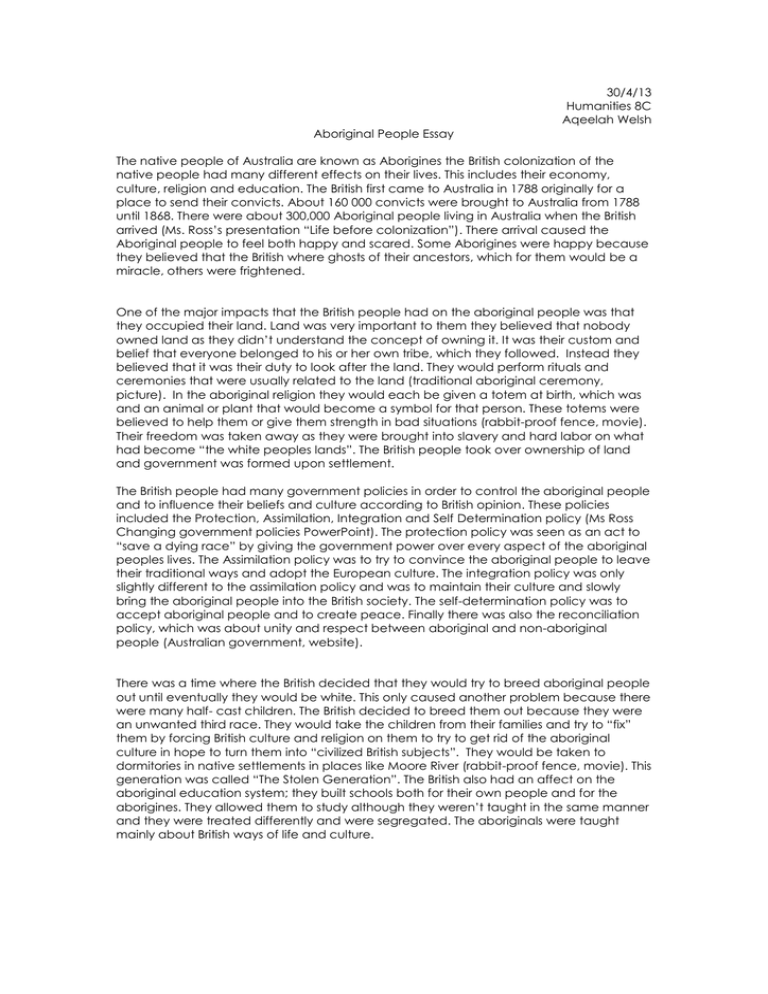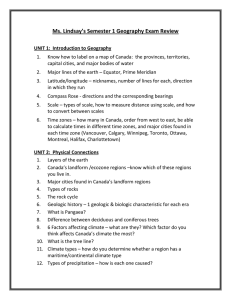30/4/13 Humanities 8C Aqeelah Welsh Aboriginal People Essay
advertisement

30/4/13 Humanities 8C Aqeelah Welsh Aboriginal People Essay The native people of Australia are known as Aborigines the British colonization of the native people had many different effects on their lives. This includes their economy, culture, religion and education. The British first came to Australia in 1788 originally for a place to send their convicts. About 160 000 convicts were brought to Australia from 1788 until 1868. There were about 300,000 Aboriginal people living in Australia when the British arrived (Ms. Ross’s presentation “Life before colonization”). There arrival caused the Aboriginal people to feel both happy and scared. Some Aborigines were happy because they believed that the British where ghosts of their ancestors, which for them would be a miracle, others were frightened. One of the major impacts that the British people had on the aboriginal people was that they occupied their land. Land was very important to them they believed that nobody owned land as they didn’t understand the concept of owning it. It was their custom and belief that everyone belonged to his or her own tribe, which they followed. Instead they believed that it was their duty to look after the land. They would perform rituals and ceremonies that were usually related to the land (traditional aboriginal ceremony, picture). In the aboriginal religion they would each be given a totem at birth, which was and an animal or plant that would become a symbol for that person. These totems were believed to help them or give them strength in bad situations (rabbit-proof fence, movie). Their freedom was taken away as they were brought into slavery and hard labor on what had become “the white peoples lands”. The British people took over ownership of land and government was formed upon settlement. The British people had many government policies in order to control the aboriginal people and to influence their beliefs and culture according to British opinion. These policies included the Protection, Assimilation, Integration and Self Determination policy (Ms Ross Changing government policies PowerPoint). The protection policy was seen as an act to “save a dying race” by giving the government power over every aspect of the aboriginal peoples lives. The Assimilation policy was to try to convince the aboriginal people to leave their traditional ways and adopt the European culture. The integration policy was only slightly different to the assimilation policy and was to maintain their culture and slowly bring the aboriginal people into the British society. The self-determination policy was to accept aboriginal people and to create peace. Finally there was also the reconciliation policy, which was about unity and respect between aboriginal and non-aboriginal people (Australian government, website). There was a time where the British decided that they would try to breed aboriginal people out until eventually they would be white. This only caused another problem because there were many half- cast children. The British decided to breed them out because they were an unwanted third race. They would take the children from their families and try to “fix” them by forcing British culture and religion on them to try to get rid of the aboriginal culture in hope to turn them into “civilized British subjects”. They would be taken to dormitories in native settlements in places like Moore River (rabbit-proof fence, movie). This generation was called “The Stolen Generation”. The British also had an affect on the aboriginal education system; they built schools both for their own people and for the aborigines. They allowed them to study although they weren’t taught in the same manner and they were treated differently and were segregated. The aboriginals were taught mainly about British ways of life and culture. Not only did the British take away the most important thing (land) they also took away the aborigines identity. They were not seen as people according to British opinion and were seen as sub-human animals. Since the British people were so advanced and developed they claimed ownership over the aborigines and their way of life. The British had a strong desire to dominate and control the native people and forced them to live according to their rule. This may have been seen as an act of kindness (by wanting to help another race) but the British murdered thousands of people and treated them inhumanely getting rid of all that the aborigines knew. Ridding them of their culture and forcing them to follow what they didn’t believe in, leaving only a few positive affects like helping the race to develop. Over all the British had a huge impact on the aboriginal people of Australia, but the negative affects override the positive. Bibliography: "History of Indigenous Australians." Wikipedia. Wikimedia Foundation, 16 May 2013. Web. 18 May 2013. <http://en.wikipedia.org/wiki/History_of_Indigenous_Australians>. "A Brief Aboriginal History." A Brief Aboriginal History. N.p., n.d. Web. 18 May 2013. <http://www.aboriginalheritage.org/history/history/>. "Aboriginal History and Culture." Aboriginal History and Culture. N.p., n.d. Web. 18 May 2013. <http://www.qub.ac.uk/imperial/austral/abo.htm>. "Language, Totems and Stories." Language, Totems and Stories. N.p., n.d. Web. 18 May 2013. <http://www.reefed.edu.au/home/explorer/hot_topics/gbr_traditional_owners/language, _totems_and_stories>. "History of Australia." - Simple English Wikipedia, the Free Encyclopedia. N.p., n.d. Web. 18 May 2013. <http://simple.wikipedia.org/wiki/History_of_Australia>. "Meaning of Land to Aboriginal People." - Creative Spirits. N.p., n.d. Web. 18 May 2013. <http://www.creativespirits.info/aboriginalculture/land/meaning-of-land-to-aboriginalpeople>.






